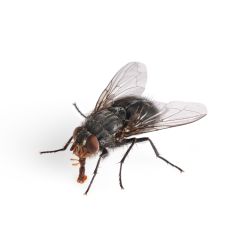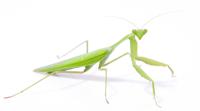 Description:
Description:
Houseflies are the most common of all domestic flies, accounting for about 90% of all flies in that live in human habitations, and are one of the most widely distributed insects, as they are found all over the world. Flies are major carriers of diseases and can infest all types of premises. They are attracted to all types of food, including human food, pet food, animal feed, food waste and even feces. Seeing adult flies is usually the most common sign of activity and a potential problem. Larvae may also be seen as they crawl out of breeding material to pupate.
Appearance:
The common house fly is a dull gray fly, ¼-inch long with four dark stripes on the middle section (thorax) of its body. House flies typically lay eggs on garbage. White, legless maggots (the larval stage) hatch from the eggs and grow to about ½ inch. When fully grown, maggots crawl away from their food source to undergo the pupal stage. They form a dark brown cocoon, known as a puparium, and later emerge as adult house flies that can fly one or two miles in search of suitable egg-laying sites.
Lifecycle:
House flies are able to quickly mature from an egg to an adult. They breed in moist decaying vegetable matter egg in uncovered garbage can or pet food. Eggs are laid in batches of 120 to 150 and can hatch in 8 – 72 hours. The larvae of House Flies can take 3 – 60 days to mature, pupae matures in 3 – 28 days.
Habits:
Indoors, house flies can be found resting on walls, floors or ceilings. Outdoors they can be seen on plants, the ground, fences, compost heaps and rubbish bins. At night them they prefer to rest near food sources approx. 5 to 15 feet off the ground.






